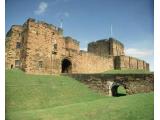Carlisle Castle
| ||||||||||||||||||||||
A joint ticket for admission to both Carlisle Castle and Cumbria's Museum of Military Life is available. Prices are valid from 1 April 2019 to 29 March 2020. Impressive and forbidding, Carlisle Castle is a formidable fortress, amply repaying exploration of its absorbing 900-year history. Long commanding the especially turbulent western end of the Anglo-Scottish border, Carlisle has witnessed many conflicts and sieges. The earliest castle (on the site of a sequence of Roman forts dating from the 1st to 4th centuries AD) was of earth and timber, raised by King William Rufus in c. 1092. During the following century it was refortified in stone, possibly by Henry I. The 12th-century stone keep is the oldest surviving structure in the castle, which was frequently updated as befitted a stronghold always in the front line of Anglo-Scottish warfare. In 1315 it triumphantly saw off a determined Scots attack. The rounded ‘shot-deflecting’ battlements of the keep were added when Henry VIII adapted the castle for artillery in c. 1540. Prices Entry Title Without Gift Aid With Gift Aid Member Free Free Adult £7.50 £8.30 Child (5-17 years) £4.50 £5.00 Concession tool-tip £6.80 £7.50 Family (2 adults, up to 3 children) £19.50 £21.60 Overseas Visitor Pass (9 or 16 days unlimited) Elaborate carvings in a small cell, by captives held here by the future Richard III in 1480, vividly demonstrate that Carlisle Castle was also a prison. Mary Queen of Scots was confined here after her flight from Scotland in 1568: but in 1596 the Border reiver Kinmont Willie Armstrong managed a daring night escape, to the fury of his captors. Carlisle played its part in the English Civil War. Besieged for eight months by Parliament’s Scots allies, its Royalist garrison surrendered in 1645 only after eating rats and even their dogs. A century later in 1746, the castle became the last English fortress ever to suffer a siege, when Bonnie Prince Charlie’s Jacobite garrison vainly attempted to hold off the Duke of Cumberland’s Hanoverian army. The fortress became their prison: many died here, and others left only for hanging or transportation. Housed in the keep is a model of the city in 1745, and an exhibition on Bonnie Prince Charlie and the Jacobite rising of that year; visitors can also see the legendary ‘licking stones’, which parched Jacobite prisoners desperately licked for moisture in order to stay alive. Admission also includes entry to the King’s Own Royal Border Regiment Museum. Another feature of the site is the Carlisle Roman Dig, a fully accessible exhibition displaying the finds from recent excavations. | ||||||||||||||||||||||
